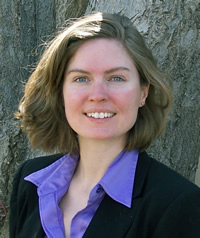Code Challenge Winners Innovate with Mashups and Mobile Solutions
By Matthew DeMeritt, Esri Writer
 Alper Dincer won $7,000 for his entry Summit ExtMap-Mashup Framework. | |
 Lisa Tunnel won first place in the ArcGIS Mobile Code Challenge for her Environmental Compliance Field Application. |
Developers of source codes that produced a highly functional Web GIS mashup and a field-ready ArcGIS Mobile application for environmental compliance inspections won first place awards in the 2009 Esri ArcGIS Code Challenge. Alper Dincer, a Web developer at the Ministry of Environment and Forestry in Ankara, Turkey, won the $7,000 first place award in the ArcGIS Server Mashup Code Challenge for his entry.
Lisa Tunnel, software developer at Digital Cartographic Services in Denver, Colorado, won the $4,000 first prize in the ArcGIS Mobile Code Challenge for her entry.
Originally called the ArcGIS Server Code Challenge, this year the contest was split into the ArcGIS Server Mashup Code Challenge and the ArcGIS Mobile Code Challenge to more accurately represent the multiple environments the ArcGIS platform supports. The Esri developer community selected the winners, who were announced at the 2009 Esri Developer Summit.
There were more than 30 entries for both challenges, which awarded cash prizes to the top two winners for each contest. This year's winners put many of the GIS and Web 2.0 advancements of last year into practice.
Dincer's application is a mashup framework based on Ext JS Framework, Google Maps API, and ArcGIS API for JavaScript Extension to the Google Maps API. Some of the capabilities in Summit ExtMap—Mashup Framework include the ability to add and remove layers from ArcGIS Online and select basemaps from Google and Microsoft Virtual Earth. The application also offers tools to perform geocoding and reverse geocoding, find altitude by clicking on the map, add data/services, query layers by attributes, and configure map settings. The mashup also has a well-designed user interface.
"The main goal of our mashup is usability rather than performance, and the inspiration point was ArcGIS Desktop ArcView," says Dincer "We wanted to make a primitive Web version of ArcView. I hope both developers and users download the source code, use it in their projects, and share their ideas about it with us."
Tunnel's company, Digital Cartographic Services, provides mobile GIS services to the mining and oil and gas industries for environmental compliance. "My organization entered the ArcGIS Mobile Code Challenge because we felt it would be an opportunity to showcase some of the mobile tools we've developed using ArcGIS Mobile 9.3," says Tunnel. "The code challenge is a great idea because it allows the mobile developer community to see what others are implementing and how it can be accomplished."
Tunnel's Environmental Compliance Field Application can be used to perform inspections for environmental compliance for mining, oil, and gas sites. Some of the application's features include turn layers on and off; select which layer to edit; sketch geometry; walk (GPS) geometry; search a layer based on attributes; select a feature to delete or modify; and pan, zoom, and identify.
 Matthew Petre took second place in the ArcGIS Server Mashup Code Challenge for his entry Flex Viewer Dice Job Searcher Widget. |
Matthew Petre, a software developer at Petris Technology in Houston, Texas, won the $3,000 second prize in the ArcGIS Server Mashup Code Challenge for his entry, Flex Viewer Dice Job Searcher Widget, which he created in eight hours using the ArcGIS Flex API. This application created from Esri's Flex Viewer allows users to search for job postings using Dice and visualize this information on top of ArcGIS Online basemaps. Petris Technology provides both text and spatial interfaces to help its customers more easily search the large amount of data from oil and gas operations that it has accumulated over the years.
"I was eager to work with the ArcGIS API for Flex . . . [so] the code challenge was a perfect excuse to try some creative things with Adobe Flex and the ArcGIS API for Flex," says Petre. "I believe I created an application that showcases the power of Flex, the performance of the ArcGIS API for Flex, and ease of development for both. We are now evaluating the ArcGIS APIs for JavaScript, Flex, and Silverlight as possible solutions to create richer user experiences for future [product] releases."
 Software developer Chad Yoder won second prize in the ArcGIS Mobile Code Challenge for his entry, ArcGIS Mobile Backup and Restore Utility. |
Chad Yoder, software developer at GeoCove in Orlando, Florida, won the $2,000 second prize in the ArcGIS Mobile Code Challenge for his entry, ArcGIS Mobile Backup and Restore Utility. As consultants to government and businesses, GeoCove provides scalable GIS programming and implementation solutions.
"We found a serious need for all mobile application users to be able to recover their work, should something happen to their original cache," says Yoder. "There are no out-of-the-box tools for data recovery from an unsyncable cache, so we built one and decided to share it with the developer community via the code challenge. I think the code challenge is a great way to inspire developers to share their ideas and tools."
The ArcGIS Code Challenge showed the technological leaps made in the previous year, with many of the developers who entered using the ArcGIS APIs for JavaScript and Flex and the advances in Web 2.0 technology. With the beta release of the ArcGIS API for Microsoft Silverlight, the developer community will continue to produce many GIS applications with compelling graphics, tighter data integration, streaming audio and video, and more.
Esri's ArcGIS platform continues to evolve by providing a robust set of APIs and tools to build next-generation GIS Web and mobile applications specifically designed for different deployment scenarios.
"It's inspiring to see so many creative and useful applications come from the challenge," says Jim Barry, program manager of the Esri Developer Network (EDN). "The code challenges are a great way to recognize developers to share tools, ideas, creativity, and code with the community. Over the past year, there has been an increase in the exchange of code among our community, and we encourage developers to continue this trend."